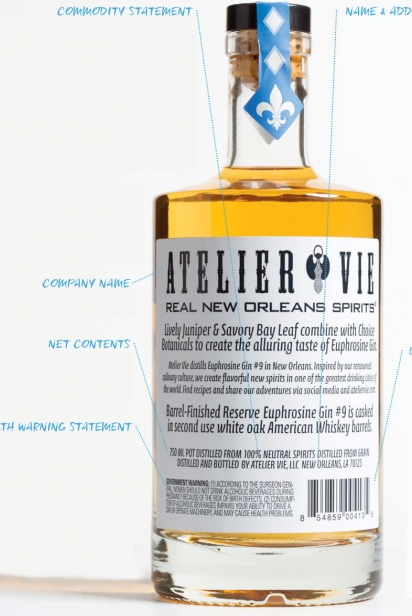Line by Line
A short journey into labyrinthian regulations governing spirit labels
If we shouldn’t judge a book by its cover, should we judge a bottle of booze by its label?
Perhaps so, at least according to the Advertising, Labeling and Formulation Division (I know, it just rolls off the tongue) of the Alcohol and Tobacco Tax and Trade Bureau of the U.S. Department of the Treasury. In fact, you should be judging that label quite a bit, which is exactly what the ALFD does for any bottle of distilled spirits intended for sale in an effort to give you clear information about what is inside that bottle.
Chances are, most of us care less about what’s on the bottle than what’s in the bottle. And while slapping on a label might seem like a simple enough affair, getting a prospective label through the ALFD’s plethora of requirements often takes months, multiple edits and re-do’s. At least that was the experience of Jed Haas, founder and one-man operator of the New Orleans craft distillery Atelier Vie.
Here, Haas takes us line by line through the labeling journey of his award-winning and recent Bon Appetit top urban distillery pick, Euphrosine Gin #9.
BRAND NAME
As Haas learned from earlier label attempts, this name must appear separate from all other text—on its own line, in its own font and type size.
Easy, peasy, you think. But wait, there’s more.
CLASS & TYPE DESIGNATION
Gin is a recognized spirit. Seems pretty straightforward until you learn that Haas’ first label attempt—GIN #9—was tagged with the dreaded “needs correction” by his label examiner. The ALFD is strict that spirit types must stand alone. Furthermore, the division assigns a numeric designation to each specific type of spirit. While the assigned number doesn’t appear on the label, neither can any other digits that would suggest a different ALFD category. For the record, Euphrosine’s official ALFD spirit number is #210.
FANCIFUL NAME
(See also, “Puffery.”) Yes, fanciful is indeed the official term. FNs are not required but may be used to denote distinguishing product characteristics. As you may have already guessed, under no circumstances may the Fanciful Name and the Brand Name be confused and the two elements must appear as clearly separate from one another.
Of course, there are caveats, even within such a fantastical sounding category. Not all distinguishing traits are deemed acceptably fanciful. For instance, Haas’ first term, “barrel-conditioned,” received a “needs correction” flag on the grounds that “conditioned” implies aging, a characteristic recognized when it comes to a spirit like whiskey, but not gin. However, in this case, Haas believes ALFD’s rebuff helped him to come up with a stronger phrase to describe his coveted Euphrosine, and he’s grown quite fond, indeed fancifully so, of “Barrel-Finished Reserve.”
PUFFERY
Not just for politicians and peacocks anymore. As Haas describes this optional element, Puffery is the “marketing speak” or all-purpose category for “stuff” that doesn’t fall into other label categories. However, even within a category whose very name seems to imply exaggeration, Haas notes that false, misleading or unfounded claims are strictly forbidden. Here, at last, the innocuous “#9” finds a home.
ALCOHOL CONTENT
Apparently size does matter. Given Euphrosine’s bottle volume, the letters displaying of the alcohol content must measure at least 2 mm high in order to meet ALFD standards. And as Haas has had to learn the hard way, don’t even think about messing with those abbreviations, those periods or that slash.
COMMODITY STATEMENT
Given how allergic we’ve become as a society, it’s probably a good thing that ALFD regulations require that consumers know about ingredients before imbibing.
However, what amuses Haas is that the back label for his regular, clear Euphrosine #9 gin reads “100% Grain Neutral Spirits.” Yet when Haas later submitted the same commodity statement for his amber Barrel-Finished Reserve, the phrase was met with a “needs correction” stamp from his ALFD examiner. Haas’s second attempt, “100% Neutral Spirits Distilled From Grain,” passed muster. To-may-toe. To-mah-toe.
POP QUIZ!
Can you guess which ALFD category such descriptions would fall under?
See answer below.*
COMPANY NAME
Not to be confused with the Brand Name or the Fanciful Name.
NET CONTENTS
Perhaps the most straightforward of any of the mandatory labeling categories, except for the fact that it involves the pesky, ever-elusive metric system.
HEALTH WARNING STATEMENT
If you’re thinking that this warning looks like every other health warning, you’d be correct. This required label element must begin with bolded capital letters, must continue in unbolded caps, must appear as a continuous paragraph, must be clearly off set from the other label elements, must appear in a contrasting color from the background, must meet a minimum size requirement based on bottle volume, etc.
NAME & ADDRESS
“Look closely,” advises Haas when reading the name and address. If the word “distilled” doesn’t appear, it’s likely the spirit was purchased elsewhere and simply bottled at the company’s address.
Haas explains that such distinctions have become contentious within whiskey circles, especially among outraged purists, as it’s now possible for a whiskey to be distilled, bottled and aged by three different companies in three different locations. So while the ALFD linguistically cracks down in other areas, certain exemptions can allow for misdirection.
“Puffery means that a bottle can tout itself as Texas whiskey on the front label in order to appeal to a certain consumer demographic,” Haas says, “when in fact the actual whiskey was made in Tennessee.” He notes that even terms such as “made by” or “produced” should not be taken to mean “distilled and bottled” as any variation to the spirit, whether it be color, flavor or dilution, allows a company to proclaim itself a maker or producer.
UPC.
While not required by ALFD regulations, Haas notes that UPCs are a necessity for distillers intent on staying in business. The bar code is invaluable to retailers as it allows them to track inventory with each purchase and to re-order when stock becomes low. *Puffery!
Rather than its current “casked” lingo, Haas’ first back label described Euphrosine #9 as “barrel-conditioned for several months.” However, just as with the frontside label, the term “conditioned” was nixed by the ALFD for its association with aging, a characteristic not recognized when it comes to gin. If only the rest of us could be so lucky.
* Feeling like your own stock of Euphrosine #9 has become perilously low? You can find Atelier Vie’s superb “sipping gin” at many New Orleans locations, including Elio’s Wine Warehouse, Keife and Co., Pearl Wine Co. and Whole Foods.






